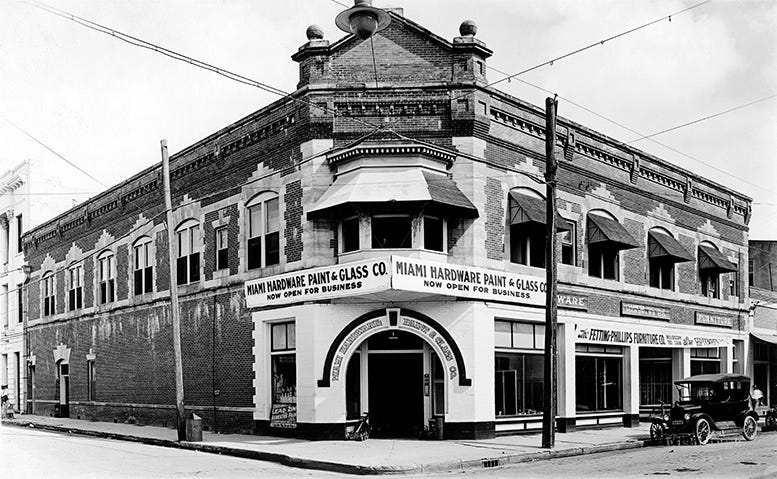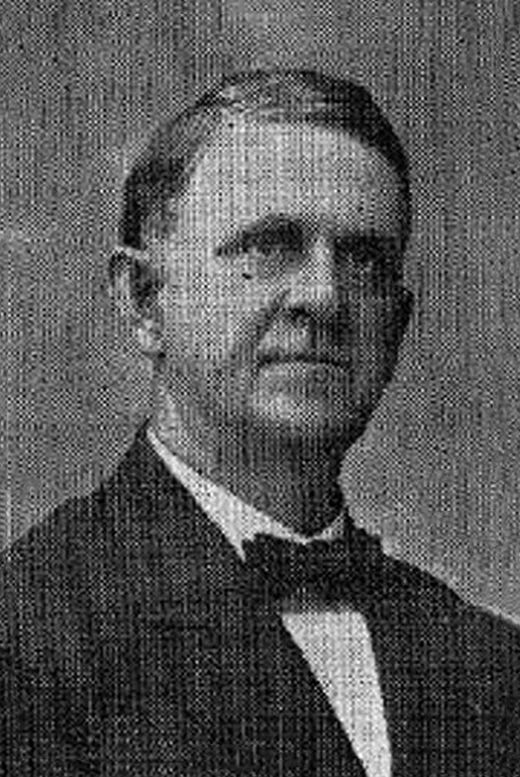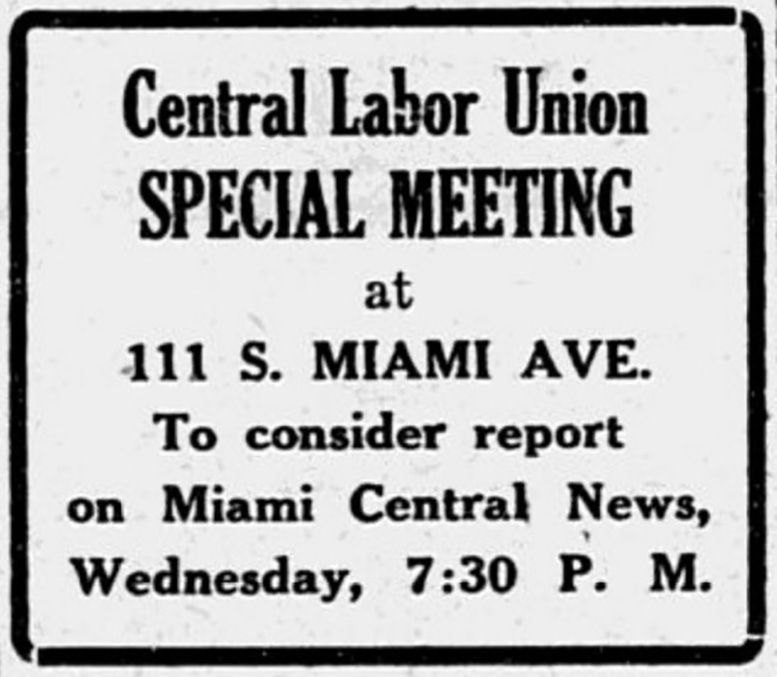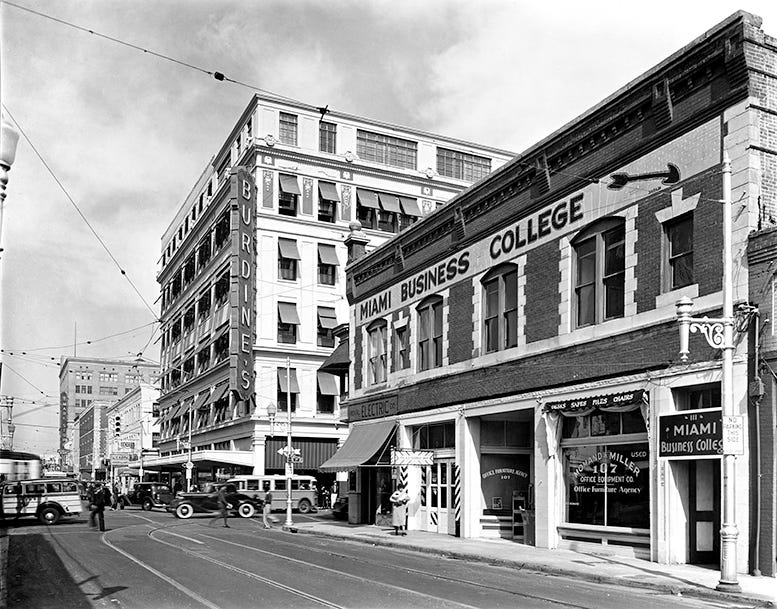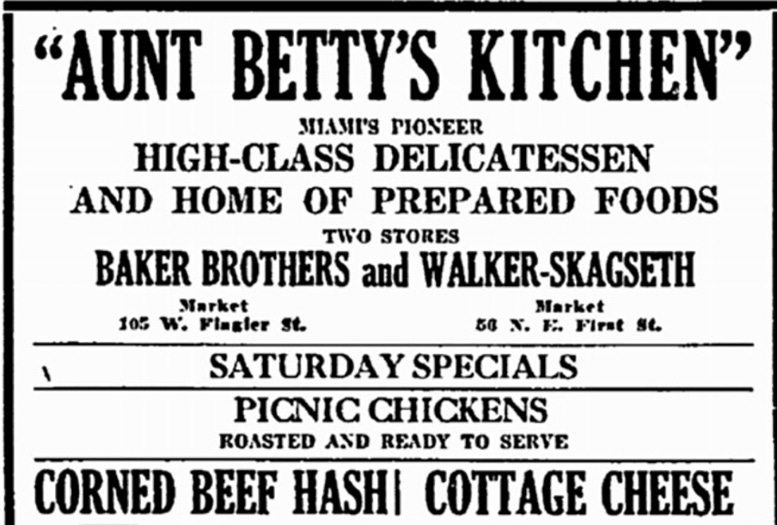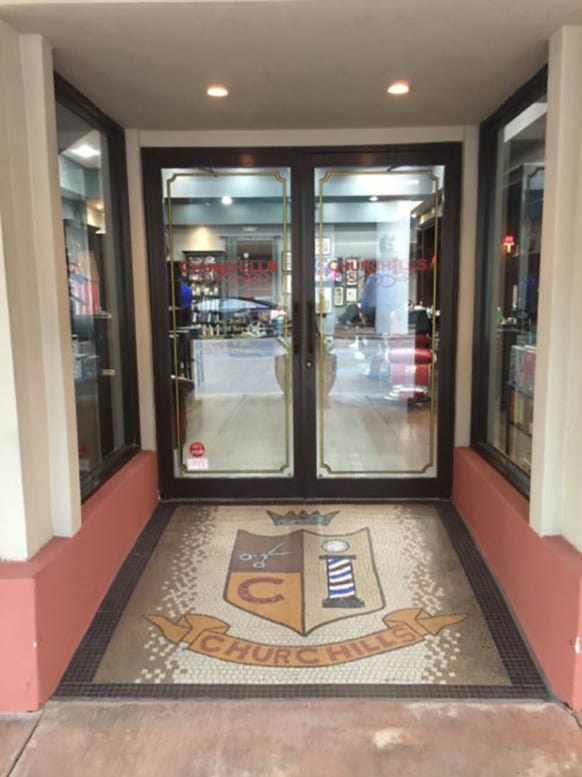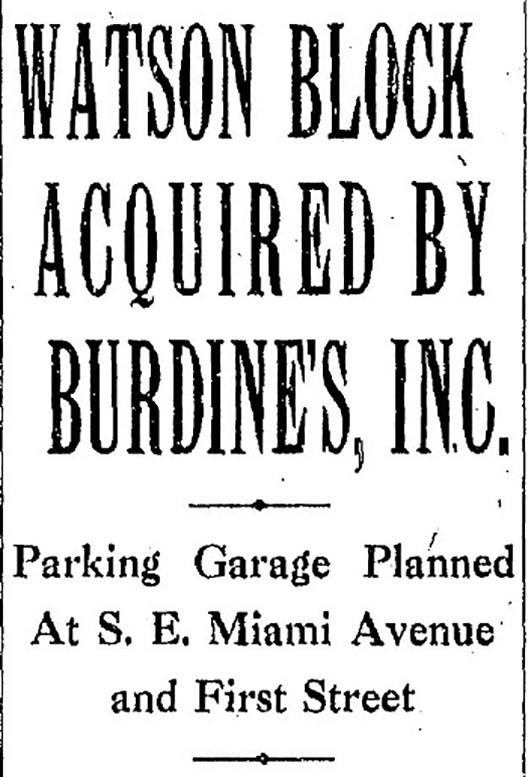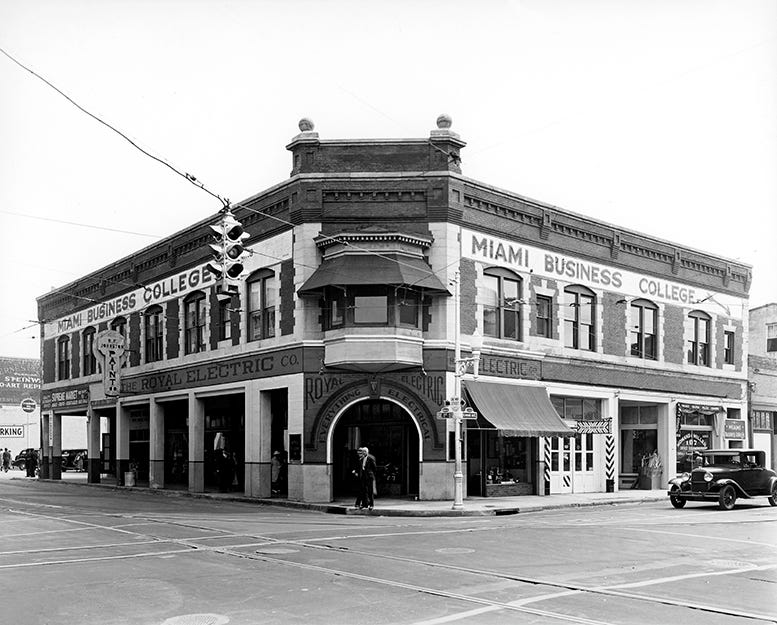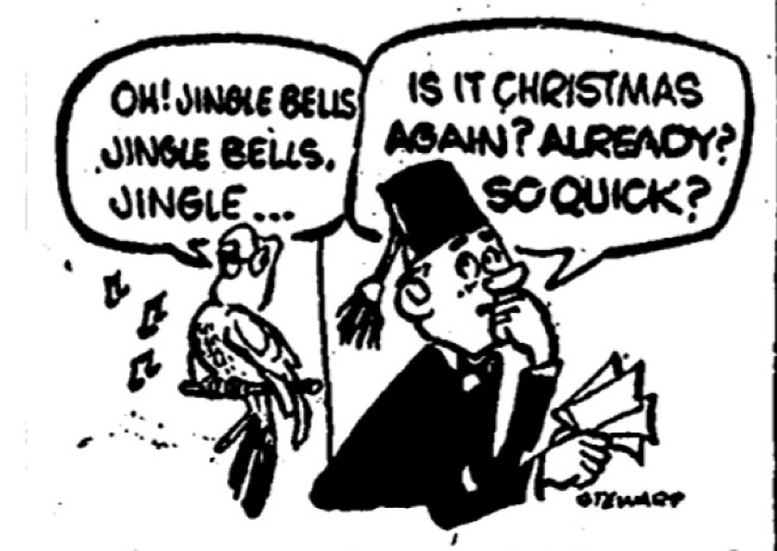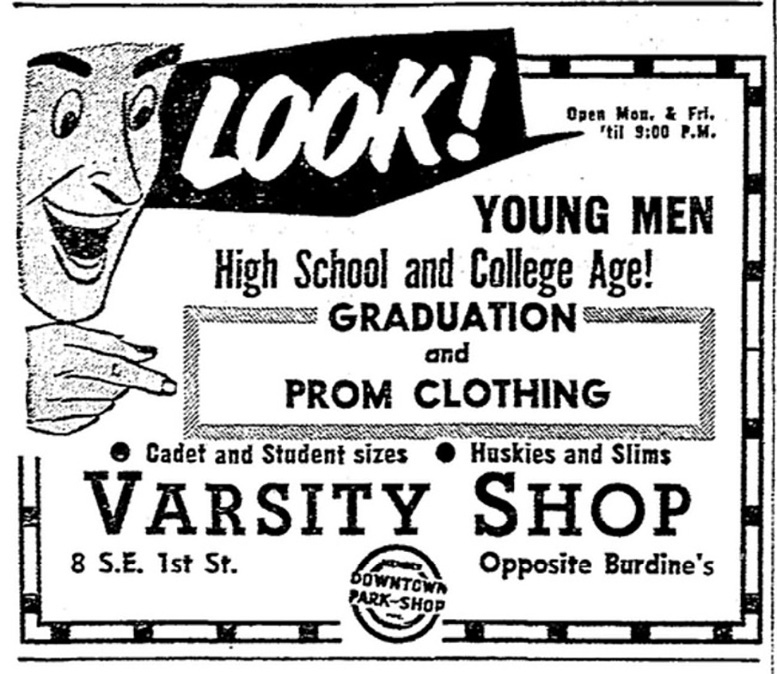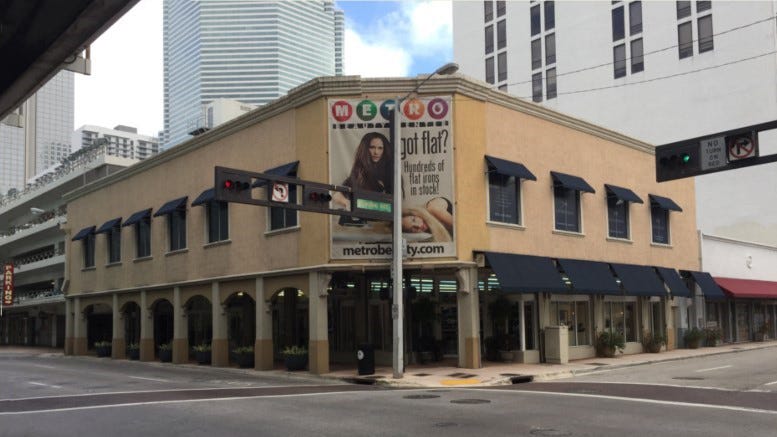Watson Building in Downtown Miami
The story of a building that was constructed by Miami pioneer John W. Watson in 1905. This building stood on the corner of South Miami Ave and SE First St for more than 115 years in downtown Miami.
John W. Watson was a business and political pioneer to Miami. Watson’s thirst for knowledge and exploration led him to Florida. That same adventurous spirit ultimately led him to Miami. He was an early merchant and a reliable public servant.
Watson opened the Miami branch of the John W. Watson Hardware Company in 1895. He managed his business interests in Miami from his home town of Kissimmee for the better part of ten years before deciding to relocate. His hardware business was started in Kissimmee.
When he decided to make Miami his permanent home, he purchased land and erected a fine two-story brick building. The structure was built in 1905 and it became the home of his hardware store. It still stands in the heart of downtown Miami today.
This is the story of a man who crafted a larger than life legacy during his time in Miami. While his story is remarkable, it is the building he erected in 1905 that best symbolizes the resiliency of early Miami.
John W. Watson Sr.
John was born on October 31, 1858, in Newbern, North Carolina. His father was from Virginia and served as a non-commissioned officer in the southern army during the Civil War. Following the war, the Watson family moved to Raleigh, North Carolina.
John was educated in the Raleigh Academy. However, at the age of sixteen, he decided to travel the American southwest. He spent time in Louisiana and Texas while working various jobs.
He returned home at the age of eighteen and worked odd jobs before moving to Georgia. After a short time in Georgia, he relocated to Cedar Keys, Florida, where he met his wife. Her name was Cora Chafer. The couple got married in 1882. From Cedar Keys, he moved to Kissimmee, where he learned the hardware business and developed an interest in public service.
It was in Kissimmee that he became actively involved in politics. John served as mayor of Kissimmee for two terms. He then moved onto president of the city council and ultimately became a state representative. He served six consecutive terms from Osceola County. During one term he was elected speaker of the House of Representatives.
After successfully operating a single hardware store in Kissimmee, John decided to expand his operation to a new and promising area. He went to Miami and established a store in 1895. His store was located in the heart of the business district on the corner of Avenue D and Thirteenth Street (South Miami Avenue and South First Street today). His second branch was so successful that Watson decided to shut down his Kissimmee store and relocated permanently to Miami in 1905.
Watson Building & Warehouse Built in 1905
Upon arriving in Miami, Watson purchased the land he was leasing for his hardware business. His business had both wholesale and retail departments and he needed enough space for a store front and warehouse.
Watson built a two-story brick building which had dimensions of seventy-five by one hundred feet. Adjoining the main building to the east, he built a three story warehouse. The address for the Watson Building was 111 South Miami Avenue.
The building was the home of more than just Watson Hardware. Once the warehouse was completed, the Knights of Pythias Masonic Lodge leased the top floor. As an article in the Miami Herald in 1911 described: “the lodge secured the lease of the entire third floor and fitted up its new lodge and ante-rooms in elegant style”.
On August 3, 1907, the Order of Eastern Star also moved into the Masonic Hall in the Watson Building. They grew in numbers and remained there for many years. Not only was John Watson the landlord, but he was also very active in the Masonic order.
In addition to fraternal organization meetings, the Watson Building was also host to political events. There were a number of advertisements and notices published in the Miami Herald in 1916 regarding meetings for the socialist party of Miami.
Other Tenants in Watson Building
Through the years, there were many businesses that operated out of the Watson Building. In the early years, there were commercial service organizations, retailers and professional service providers.
Some of the tenants included John Nix & Co Produce, and the Rubber Stamp Company. Other tenants were Hygenic Dental Parlors, Fetting & Phillips Law, Howard Zeigler Inc. and the architectural firm of Lingler & Beshgetoorian.
The Watson Building was near the center of town and was in high demand. John’s success with his flagship commercial building inspired him to seek additional commercial real estate opportunities.
John Watson Sells Hardware Business
The John W. Watson Hardware Company experienced steady growth from the time he relocated to Miami. However, by the later part of the 1910s, he decided it was time for a change. John sold his hardware retail and wholesale business in 1917 to concentrate on his political career and other business interests.
Following the sale, Watson stayed very active investing in property. He owned a forty-acre grapefruit grove at the edge of the Everglades that operated as a very productive syrup farm in the early 1920s.
Watson’s second commercial real estate investment was in a prime location on Flagler Street. The building was built in 1920 and located on the corner of Flagler Street and NW First Court. The latter street no longer exists. The building was located about where the ramp begins on Flagler Street for the Miami-Dade Public Library and HistoryMiami. The address was 105 West Flagler Street.
Once it opened, the primary tenant was Baker Brothers Meat Company. They were one of the largest butchers and meat distributors in early Miami and occupied about three quarters of the building. Baker Brothers were so big that they had to install the largest refrigerator in Miami at the time.
The rear of the building was partitioned for a couple of additional businesses. One of the other businesses was “Aunt Betty’s Kitchen”. It was a popular delicatessen. The deli made good use of having one of the largest meat distributors as a neighbor. It is likely that this building was razed in the early 1980s to make room for the Miami Cultural Center.
John Watson’s Political Career
John was civic minded and was very active in politics from the time of his arrival to Miami. He immediately became involved with the Miami Board of Trade, now called the Miami Chamber of Commerce. He was also active in the Elks Lodge and the Knights of Pythias Masonic order.
Just as he was active in the business community and social circles, John also ran for public office. Beginning in 1906, he represented Dade County in the state legislature. He ran for governor in 1912, but failed to secure his party’s nomination. Watson then turned his attention to local politics and became a three time Mayor of Miami. He served as mayor from 1912 – 1915 and then from 1917 – 1919.
Watson was not afraid of controversy and a good fight. Upon the failing of the Fidelity Bank and Trust Company, it was Watson that challenged another prominent Miami pioneer over the reopening of the financial institution. The fight put him at odds with Edward C. Romfh, a man who would also serve as Mayor of Miami in the mid-1920s.
As a state representative, John was a champion of education and encouraged legislation that would better the quality of schools within Florida. He was also responsible for pushing the passage of the state’s first pari-mutual wagering law.
Excluding his time as Mayor of Miami, Watson served in the state legislature from 1906 until he retired in 1936. He was a state senator when Franklin D. Roosevelt was almost assassinated in Bayfront Park in February of 1933. Watson and his wife were seated next to John Sewell on the band shell stage when shots were fired. The Watsons were fortunate not to have been hit by any of the stray bullets.
Original Watson Building Reconfigured in 1923
By 1923, the original configuration of the Watson Building was no longer optimal. The hardware store wasn’t in business and it was time to reconfigure the building to accommodate more tenants.
The original configuration consisted of two large store rooms divided by a single wall. Watson hired the architectural firm Pfeiffer and O’Riley to design the reconfiguration. They were tasked with subdividing the space into nine store rooms and shops.
Once the reconfiguration was complete, the Watson Building’s tenants consisted of a cold drink and cigar store on the corner, a barbershop, and a printer that occupied two store rooms along South Miami Avenue. Ironically, almost a hundred years after the 1923 reconfiguration, one of the tenants in the building is a barbershop. I have been getting my haircut at Churchill’s Barbershop for the last eight years.
Watson Block Acquired by Burdines in 1930
There were two trends that changed downtown Miami by 1930. Burdines had steadily grown in popularity and size, and the automobile had become the preferred mode of transportation for Miami.
residents. While everyone felt the impact of the Great Depression, Roddy Burdine was not discouraged by economic conditions and continued to pursue his growth plan.
On September 3, 1930, Burdines Inc. purchased all of the buildings on what was referred to as the Watson block. This included the Watson Building and the adjoining three story warehouse. The Masonic Hall still leased the third floor of the warehouse at this time.
The purchase was done in anticipation of economic recovery and future growth. The plan was to ultimately raze all of the buildings on the block and to build a parking garage to complement Burdines Department Store.
However, economic conditions forced Roddy Burdine to continue to lease the retail and office space until things changed. By the mid-1930s, Burdines Inc. signed a notable client to lease the top floor of the Watson Building.
Miami Business College
The Miami Business College was founded in 1912 and provided vocational training and education to students in downtown Miami. Although it changed addresses frequently, it remained in downtown Miami from its inception.
Prior to moving to the Watson Building, the college was located in the Exchange Building until 1935. The college signed a lease to occupy the entire second floor of the Watson Building beginning in 1936.
However, the college only remained in the building for three years. It moved to a building on Biscayne Boulevard and then added a second location on Flagler Street by 1940.
Alray Shoe Store & Perky
Following World War II, the Watson Building began to be an extension of the downtown shopping scene. Men’s clothing and a shoe store became the anchor tenants for the Watson Building.
One of the more interesting stores to occupy one of the ground floor shops in the Watson Building was Alray Shoe Store. The store operated out of 12 SE First Street from 1955 through the 1960s.
Alray wasn’t necessarily interesting because of it shoe selection. It had more to do with the store mascot. Perky was a very smart and talkative parrot.
When he was first brought to the store, it was around Christmastime and the Shriners were practicing their carols in the parking lot next door. Perky quickly learned Jingle Bells and began singing it in the store. However, Perky didn’t know when to stop singing the Christmas song and continued to do so months into the following year. Customers didn’t know what to make of a parrot singing Christmas songs out of season.
Perky also had picked up the habit of whistling at women when they walked by the store. Most women would initially be startled or offended, but then would howl with laughter when they saw that it was Perky who was whistling at them.
If the parrot noticed a preoccupied passerby he would wake them with a cheery “hello” and then a hearty “goodbye”. Perky was as much part of the Watson Building as any of the tenants.
One of the last articles written on Perky was in 1967 announcing that he was turning eighteen years of age. It was also the last time that Alray Shoe Store made it into a Miami Herald article.
The Varsity Shop
Edward Soule worked in the clothing business from the time he arrived to Miami in 1941. He was a World War I veteran from Canton, Ohio, who had a dream to run his own store.
He got that chance when he opened The Varsity Shop at 8 SE First Street in the Watson Building. He started his business in 1952 and it became an important stop for young men that were in high school or college.
The store offered clothing for all occasions and all sizes for young men. Miami residents coming of age in the 1950s and 1960s remember buying their school, prom or graduation clothing from the Varsity Shop.
Soule operated his store until failing health forced him to retire in 1965. He passed away on August 11, 1973. Following Soule’s retirement and sale of the business, the store would modify its name to Christie’s Varsity Shop. It was still in business in the Watson Building as late as 1975.
John W. Watson’s Legacy
John Watson’s legacy can be measured by any number of factors: political career, contributions as a pioneer merchant, real estate developer or his family. There are not many individuals who have rounded out a political resume by serving as Mayor of Miami for three terms and following that with close to twenty five years in the state legislature.
Watson had enough vision to invest in Miami before it even had a name. He ran a hardware business that was instrumental in building Miami during its early years.
His children also understood the importance of civic duty and serving their adopted home. John Watson Jr. served as Miami City Attorney for nearly thirty years before he retired.
John Watson’s contribution to Miami’s history was highly regarded by those around him. Following his death on February 8, 1942, a generically named island along the County Causeway was renamed in his honor. Causeway Island was changed to Watson Island. County Causeway was also later renamed to McArthur Causeway.
An overlooked contribution of John Watson’s legacy is the structure he built when he arrived in 1905. The Watson Building still stands and is a vibrant commercial building the in heart of downtown Miami. All the stores and offices have tenants and the building appears to be well maintained.
While the building may appear to be dated and out of place in a modern city, it sits as a symbol of resilience. It could have been razed when Burdines purchased the land in 1930, but it survived demolition for a reason.
It remains to remind modern day Miami residents of a time forgotten. A time when pioneers left everything behind to take a chance on a promising new city. While the Watson Building does not currently have local historic protection, it certainly should. It would be a shame to lose a great symbol of resilience in the name of progress.
Resources:
Book: “Miami and Dade County Florida”, E.V. Blackman (pages 203 – 205)
Book: “Miami Memoirs”, John Sewell
Miami Herald: “Brief Resume of Fraternal Orders”, July 22, 1911
Miami Herald: “Order of Eastern Starts”, August 10, 1911
Miami Herald: “Meeting of Socialists”, March 13, 1916
Miami Herald: (Second) “Watson Building is Being Erected”, June 2, 1921
Miami Herald: “Ten Acres of Cane Yield 4,000 Gallons of Syrup…”, December 11, 1921
Miami Herald: “Start Remodeling Watson Building”, October 11, 1923
Miami Herald: “Watson Block Acquired by Burdines, Inc.”, September 3, 1930
Miami Herald: “Ex-Mayor Watson is Dead”, February 9, 1942
Miami Herald: Obituary – “Clothing Shop Owner Soule, 76”, August 12, 1973
Images:
Cover: Watson Building in the early 1910s. Courtesy of Florida State Archives.
Figure 1: Portrait of John W. Watson Senior. Courtesy of the Miami Daily News.
Figure 2: Ad for meeting of socialists on June 20, 1921. Courtesy of Miami Herald.
Figure 3: Watson Building looking north on Miami Avenue in 1936. Courtesy of Florida Memory.
Figure 4: Ad for Aunt Betty’s Kitchen in 1922. Courtesy of Miami Herald.
Figure 5: Churchill’s Barbershop in Watson Building in 2016. Courtesy of Casey Piket.
Figure 6: Headline in Miami Herald in 1930. Courtesy of Miami Herald.
Figure 7: Miami Business College in Watson Building in 1936. Courtesy of Florida Memory.
Figure 8: Cartoon of Perky the Parrot singing Jingle Bells in 1955. Courtesy of Miami Herald.
Figure 9: Ad for Varsity Shop in 1958. Courtesy of Miami Herald.
Figure 10: Watson Building in 2016. Courtesy of Casey Piket.


